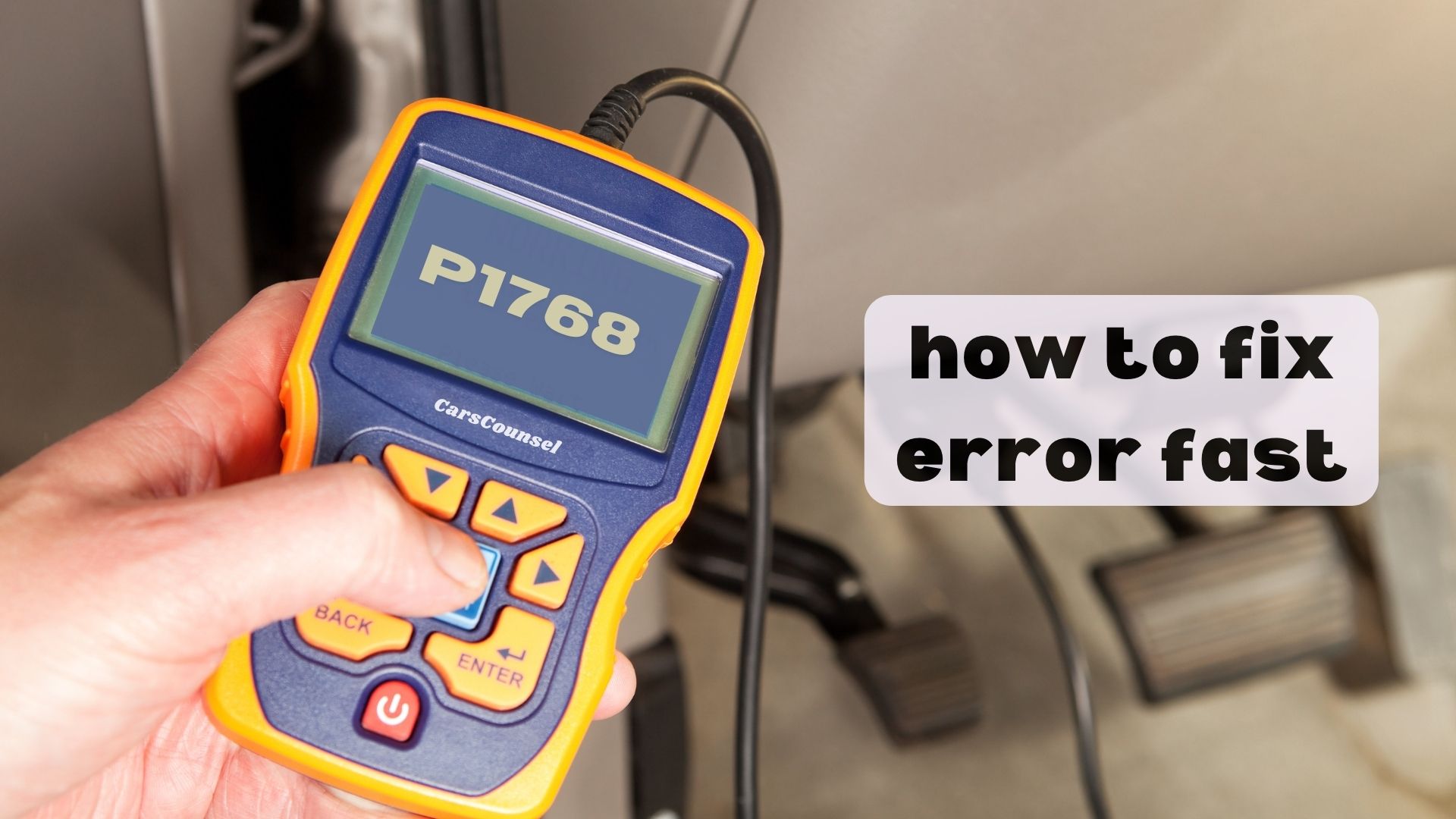You might not know that your vehicle’s clutch control solenoid valve plays a vital role in smooth gear shifts, but a malfunction can trigger the P1768 code. This code definition varies by vehicle make, but it generally indicates a problem with the solenoid valve.
As you examine the possible causes, you’ll find that faulty solenoid valves, wiring issues, and corrosion are common culprits. But what exactly is happening under the hood, and how can you get your vehicle running smoothly again?

Quick Navigation
Key Takeaways
- The P1768 code definition varies by vehicle make, referring to different transmission-related issues in Acura, Honda, Isuzu, Ford, and Mitsubishi.
- Possible causes include faulty clutch pressure control solenoid valves, wiring issues, poor electrical connections, and corrosion in the solenoid valve circuit.
- Symptoms may include clutch failure signs, erratic shifts, decreased fuel efficiency, sudden loss of power, and unusual transmission behavior.
- To fix the issue, review possible causes, inspect the wiring harness and connectors, and repair or replace damaged components as needed.
- It is essential to consult the vehicle’s repair manual or online resources for specific troubleshooting procedures due to varying code meanings by vehicle make.
Code Definition
The P1768 code definition varies depending on the vehicle make.
For Acura, Honda, and Isuzu, it refers to the A/T Clutch Pressure Control Solenoid Valve Circuit.
In Acura, Honda, and Isuzu vehicles, code P1768 relates to the A/T Clutch Pressure Control Solenoid Valve Circuit malfunction.
In Ford, it indicates a Performance / Normal / Winter Mode Input Malfunction.
Meanwhile, in Mitsubishi, it’s related to the Transaxle Control Relays Always Off.
Generally, the error code is associated with the malfunction of the clutch control solenoid valve, which is responsible for shift control and lock-up control.
The Powertrain Control Module (PCM) measures the current flowing through the valve and detects a malfunction if it’s not within a specified range.
Possible Causes
When your vehicle throws a P1768 code, it’s time to investigate the possible causes.
You’ll need to check for faulty clutch pressure control solenoid valves, which can malfunction due to electrical issues. Inspect the related wiring harness and connectors for signs of damage, corrosion, or wear.
Wiring issues, such as open or shorted circuits, can also trigger this code. Additionally, poor electrical connections or corrosion in the solenoid valve circuit can cause problems.
Symptoms
You’ve probably noticed some unusual behavior in your vehicle’s transmission if the P1768 code has been triggered.
As the clutch pressure control solenoid valve malfunctions, you may experience clutch failure signs like slipping or hesitation when shifting gears.
Transmission problems may manifest as erratic or incomplete shifts, causing your vehicle to jerk or stumble.
You might also notice a decrease in fuel efficiency or a sudden loss of power.
These symptoms can lead to more severe damage if left unchecked, so it’s essential to address the underlying issue promptly.
How to Fix
To fix the P1768 code, start by reviewing the possible causes listed above, which may include a faulty clutch pressure control solenoid valve, an open or shorted harness, or a poor electrical connection in the circuit.
Begin by reviewing possible causes, including faulty solenoid valve, open/shorted harness, or poor electrical connection.
Next, visually inspect the related wiring harness and connectors for damage, looking for broken, bent, pushed out, or corroded connector pins.
Repair or replace damaged components as needed.
For Smart Fixing, consider using the AutoCodes app, which provides repair solutions and cost estimates, plus AI chat support on demand to help you diagnose and fix the issue efficiently.
Vehicle-Specific Information
The P1768 code has different meanings depending on the vehicle make and model.
You’ll find that certain manufacturers assign unique definitions to this code. For instance, in Acura, Honda, and Isuzu vehicles, P1768 refers to an issue with the A/T clutch pressure control solenoid valve circuit.
In Ford vehicles, it indicates a malfunction in the performance/normal/winter mode input. Meanwhile, in Mitsubishi vehicles, it’s related to the transaxle control relays always being off.
Understanding your vehicle’s history and model variations is vital to accurately diagnose and repair the issue.
Diagnostic Tips
When diagnosing the P1768 code, it’s essential to follow a structured approach to identify the root cause efficiently.
You’ll want to utilize Smart Diagnostics and Advanced Troubleshooting techniques to pinpoint the issue.
- Don’t overlook the basics: Check the wiring harness and connectors for damage or corrosion.
- Use a multimeter to measure voltage and resistance in the Clutch Pressure Control Solenoid Valve circuit.
- Consult your repair manual or online resources for specific troubleshooting procedures for your vehicle’s make and model.
Repair Solutions
You’ll need to develop a repair plan that addresses the root cause of the P1768 code, which could be a faulty Clutch Pressure Control Solenoid Valve, a wiring harness issue, or a poor electrical connection.
| Repair Step | Action | Expert Tip |
|---|---|---|
| Visual Inspection | Check wiring harness and connectors | Look for broken, bent, or corroded pins |
| Component Check | Inspect Clutch Pressure Control Solenoid Valve | Check for signs of damage or wear |
| Smart Diagnosis | Use AutoCodes app for complete OBDII diagnostics | Get expert advice with AI chat support on demand |
With a smart diagnosis and expert advice, you’ll be able to identify and fix the issue efficiently.
Cost Estimates
Your P1768 code repair plan should include a thorough review of the estimated costs involved, as this will help you prepare for the financial implications of fixing your car.
You’ll want to research auto repair shops and compare insurance quotes to find the best deal.
- Don’t let unexpected repair costs drain your bank account!
- Get a clear picture of the costs involved to avoid financial stress.
- Stay on top of your car’s repair needs to avoid costly surprises down the road.
More OBD-II Codes
| P1668 | P1738 | P1739 | P1753 |
| P1758 | B1234 | B1233 | B1209 |
| B1208 | B1203 | P0449 | U1017 |
| P1166 | P1167 | P1168 | C1604 |
| C1611 | C1612 | B0527 | B2947 |
| C1613 | C1616 | B0285 | B0286 |
Frequently Asked Questions
Can I Drive My Car With a P1768 Code?
You’re wondering if it’s safe to drive with a P1768 code. While it’s possible to drive, you’re risking transmission damage and compromising your safety. Driving limitations may apply, and safety risks are high, so it’s recommended to address the issue promptly to avoid further complications.
Will a P1768 Code Cause My Car to Fail an Emissions Test?
As you rev up your chariot, wondering if a P1768 code will sabotage your emissions test, rest assured it might not be a deal-breaker. However, it’s vital to note that faulty transmission control can impact emissions standards, potentially failing inspection requirements.
Can a Faulty PCM Cause a P1768 Code?
You’re wondering if a faulty PCM can cause a P1768 code. Yes, it’s possible. A PCM malfunction can disrupt transmission control, leading to transmission slippage and incorrect clutch pressure control solenoid valve operation, triggering the P1768 code.
Will a P1768 Code Trigger the Check Engine Light?
You’re wondering if a P1768 code will trigger the check engine light. Investigating this theory reveals that, yes, it will, as diagnostic protocols detect error thresholds, prompting the illumination of the check engine light to alert you of a malfunction.
Can a P1768 Code Be Caused by Low Transmission Fluid?
You’re wondering if a P1768 code can be caused by low transmission fluid. Yes, it’s possible, as low fluid levels can lead to transmission slippage, affecting the clutch pressure control solenoid valve’s operation and triggering the code.
Conclusion
You’ve diagnosed the P1768 code, now it’s time to take action. Remember, a faulty clutch control solenoid valve can lead to more than just erratic shifts – it can cause your transmission to fail entirely. In fact, did you know that transmission problems are the leading cause of breakdowns in vehicles over 10 years old, with over 40% of failures occurring due to faulty solenoid valves? Fix the issue promptly to avoid costly repairs down the road.

